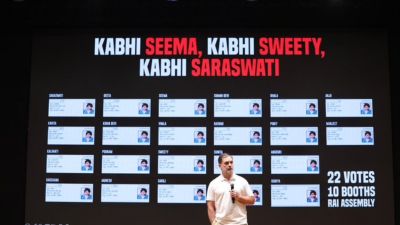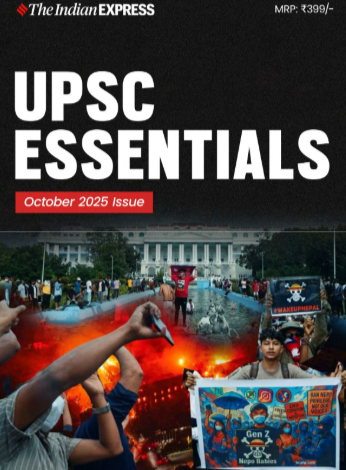
Preliminary Examination: Current events of national and international importance.
Mains Examination: General Studies-II, III: Government policies and interventions for development in various sectors and issues arising out of their design and implementation, defence.
Story continues below this ad
What’s the ongoing story: Prime Minister Narendra Modi on Friday inaugurated the 16th Combined Commanders’ Conference (CCC) at the Army’s Eastern Command headquarters in Kolkata, and urged the armed forces to pursue “greater synergy, atmanirbharta and innovation” as part of the government’s push to make 2025 the “year of reforms” in defence.
Key Points to Ponder:
— What is the significance of the Combined Commanders’ Conference?
— Read about Operation Sindoor.
— What are integrated theatre commands?
— What is the theaterisation of the Armed Forces?
— What are some important developments in India’s defence sector?
— What are the key issues and challenges faced by India’s defence sector?
— What is the significance of boosting indigenisation in the defence sector?
Key Takeaways:
Story continues below this ad
— The PM was briefed on operational readiness in the context of the “new normal” created by Operation Sindoor and on the future of warfare amid emerging technologies and tactics. He also reviewed reforms undertaken over the past two years and the roadmap for the next phase.
— Held once every two years, the conference is the apex forum that brings together the nation’s top civilian and military leadership to chart the path of India’s defence preparedness, the Ministry of Defence said in a statement, adding the 2025 edition is being held under the theme ‘Year of Reforms – Transformation for the Future’.
— Modi complimented the armed forces for the success of Operation Sindoor and their role in nation-building, anti-piracy missions, safe return of Indian citizens from conflict zones and humanitarian assistance and disaster relief operations in friendly countries. He instructed the Defence Ministry to take concrete steps to meet future challenges.
— The conference is being attended by Defence Minister Rajnath Singh, National Security Adviser Ajit Doval, Chief of Defence Staff General Anil Chauhan, Tri-service chiefs and Defence Secretary Rajesh Kumar Singh, among others. It was last held in Bhopal in 2023, which was inaugurated by Modi.
Do You Know:
Story continues below this ad
— Each of the three services also holds its own service-specific commanders’ conference annually.
UPSC Mains Question Covering similar theme:
📍What is the significance of Integrated Theatre Commands? Discuss the challenges of implementing integrated theatre commands in India.
FRONT
Syllabus:
Preliminary Examination: Indian Polity and Governance – Constitution, Political System, Panchayati Raj, Public Policy, Rights Issues
Story continues below this ad
Mains Examination: General Studies-II: Government policies and interventions for development in various sectors and issues arising out of their design and implementation
What’s the ongoing story: Underlining that it is not inclined to stay the entire law, the Supreme Court, in an interim order Monday, limited the contentious powers the new law granted to the District Collector in determining the status of a waqf property and also capped the non-Muslim representation in Waqf Boards, two key issues flagged by several parties and groups that have opposed the law and had sought a stay on it.
Key Points to Ponder:
— What do you understand by “waqf by user”?
— What is separation of powers doctrine? Why is it important?
— What is the purpose of Waqf land?
— Why did the government bring an amendment to the Waqf?
Story continues below this ad
— What is the role and function of the Waqf Council?
— What is the difference between trusts and waqf?
Key Takeaways:
— However, it upheld the deletion of “waqf by user” saying that if the legislature finds examples of its misuse, it is justified in deleting that provision.
— The bench directed the government to pause the provision under which only those practising Islam for at least five years can create a waqf till state governments can frame rules on how to make that determination.
— At the same time, it said that the provision cannot be said to be arbitrary or discriminatory. It said that as early as 1923, the legislature had noticed that it was common that a Waqf endowment be regarded by the public as a “clever device” to tie up property in order to defeat creditors and “generally to evade the law under the cloak of a plausible dedication to the Almighty.”
Story continues below this ad
— On the representation of Muslims in the Waqf bodies, the SC ruled that the Central Waqf Council constituted under the 2025 Act shall not consist of more than four non-Muslim members out of 22 and the state Board, not more than three non-Muslim members out of 11.
— It also directed that, as far as possible, effort should be made to appoint the Chief Executive Officer of the Board who is the ex-officio Secretary from amongst the Muslim community.
— The court declined to stay the crucial provision that was challenged by the petitioners on the law doing away with the concept of “Waqf-by-user”. Waqf-by-user is a status for land used for Muslim religious or charitable purposes for a long period of time. Such land is deemed to be a waqf even if it was not registered as such.
— The 2025 law does away with the concept of waqf-by-user for future transactions, and restricts it only to those that are already registered as waqf.
Story continues below this ad
— The court found that if the legislature, noticing the misuse of properties and encroachment of government lands through this concept, decides to abolish it prospectively, the amendment prima facie cannot be said to be arbitrary.
— Powers of the District Collector: The petitioners had challenged Section 3C of the amended Waqf Act, which empowered a district collector (or a designated officer) to inquire whether a property claimed as Waqf is actually government property.
— A key point of contention was a provision in this section which stated that the moment an inquiry began, the property would immediately cease to be treated as Waqf, even before a final decision was made. The Supreme Court stayed this specific provision. This means that a property will retain its status as a Waqf property while any such inquiry is pending.
— Inclusion of non-Muslims in Waqf boards: One of the primary arguments of the petitioners was that the new law allowed for a non-Muslim majority in Waqf boards and the Central Waqf Council, which they argued was a violation of their right to manage their own religious affairs.
Story continues below this ad
— While the Centre argued that the number of non-Muslims would be limited, the Supreme Court, to avoid ambiguity, issued a specific direction. It ordered that the Central Waqf Council, which has 22 members, shall not consist of more than four non-Muslim members. Similarly, it directed that State Waqf Boards, with 11 members, shall not have more than three non-Muslim members.
— The ‘practising Islam for 5 years’ rule: The 2025 Act amended the very definition of ‘Waqf’, stating that it could only be created by a “person showing or demonstrating that he is practising Islam for at least five years”. The petitioners argued this was discriminatory and arbitrary.
— The Supreme Court has stayed this provision, but with a condition. The stay will remain in effect until the government frames rules and provides a clear mechanism for determining how a person’s religious practice over five years is to be ascertained.
— Applicability of the Limitation Act: The 1995 Waqf Act had specifically excluded the application of the Limitation Act, which allowed Waqfs to act against encroachments on their properties without any time limit. The 2025 law removed this exemption, meaning legal claims against encroachment must be made within a specific period. The court did not stay this provision, observing that its application removes a discrimination that existed earlier.
— The court clarified that its observations are prima facie for the purpose of deciding the interim stay and would not prevent the parties from making detailed arguments on the validity of the law during subsequent hearings.
Do You Know:
Editorial: SC’s interim order offers no relief from several problematic provisions of Waqf law
— Faizan Mustafa writes: The Court has temporarily stayed Section 3(r) of the Act till rules to determine who is a practising Muslim for five years are framed. This section of the interim order is problematic as it gives the executive officials powers to adjudicate the religiosity of citizens.
— Are we going to have moral policing along the lines of Iran? A person’s claim should be enough to determine his or her religious identity. Section 3(r) uses the term “professing Islam”, but the CJI Gavai-led bench has used the expression “practising Islam”. This gives state officials a say on religious rectitude – on the performance or non-performance of religious duties.
— In other words, a Muslim who prays just once a week on Friday or does not keep fasts or lies or takes bank interest or does not pay zakat may not be certified as “practising Islam”.
— The court’s justification that petitioners have themselves argued that waqf is unique to Islam is not a convincing reason to justify this exclusion. This is because the argument is in the context of a concept novel to Islam, where the owner loses control over his own property.
— The right of a property owner has nothing to do with any religious law as it is part of the general jurisprudence, common to all legal systems. An owner is free to do whatever he wants with his property, including destroying or alienating it the way he or she wants. By denying a non-Muslim owner of properties the right to create a waqf, the Act infringes the ownership rights of non-Muslims.
— A waqf is different from a trust. A waqf’s founder cannot take any benefits for himself or herself. Unlike trusts, a waqf is perpetual, irrevocable, and inalienable. The property in trust vests rights in the trustee, but in waqf, it vests them in God. If an owner does not want to create a trust, can the law force him?
Other Important Articles Covering the same topic:
📍What are the key issues in the challenge to the new Waqf law
Previous year UPSC Mains Question Covering similar theme:
📍How is the Indian concept of secularism different from the western model of secularism? Discuss. (UPSC CSE 2018)
Syllabus:
Preliminary Examination: Current events of national and international importance
Mains Examination: General Studies-III: Indian Economy and issues relating to planning, mobilisation, of resources, growth, development and employment.
What’s the ongoing story: IN JUST three years, the Bureau of Indian Standards (BIS) has issued as many as 84 Quality Control Orders (QCOs) based on the recommendations of various ministries and departments, which is almost 45% of all 187 QCOs administered by it. These 84 QCOs cover 343 products.
Key Points to Ponder:
— What is the purpose of the QCOs?
— What is the process of issuing QCOs in India?
— What are the concerns raised by MSMEs in this regard?
— The deliberations on QCOs also assume significance in the backdrop of India negotiating trade deals. — What do you understand about this?
— Which authority is responsible for formulating the Indian Standards for different products?
— How does the QCOs curb cheap quality imports?
— What is the WTO Agreement on Technical Barriers to Trade?
Key Takeaways:
— QCOs are legal orders issued by departments or ministries under the BIS Act, which make it mandatory for domestic and imported products, to conform with certain quality standards. The products cannot be sold unless they get a certification from the BIS.
— But over the last two years, micro, small and medium enterprises have complained to the government that the QCOs are akin to non-tariff barriers, and have raised cost of inputs for them.
— According to government data, of the total187 QCOs notified till date, a majority i.e., 86 QCOs (covering 362 products) were issued on the recommendation of the Department for Promotion of Industry and Internal Trade under the Ministry of Commerce and Industry, followed by 69 QCOs (covering 74 products) on the recommendation of the Department of Chemicals and Petrochemicals and 10 QCOs (covering 76 products) on the recommendation of the Ministry of Textiles.
— Year-wise QCO data shows that from just 10 QCOs in 2022-23, the numbers increased to 59 in 2023-24. In 2024-25, it dropped to 15, and in the current financial year till date, four QCOs have been notified.
— Explaining the process of issuance of QCOs in India, an official said the concerned line ministry identifies products which require mandatory compliance to standards. It then holds consultation with all stakeholders including industry and the BIS and then prepares a draft QCO.
— Before finalising the QCO, the draft is hosted at the World Trade Organization (WTO) Technical Barrier to Trade (TBT) website where other countries can comment.
— Thereafter, the line ministry issues the QCOs giving usually 6 months or more time to implement them by the industry.
— The deliberations on QCOs also assume significance in the backdrop of India negotiating trade deals with the US and the European Union and navigating through the 50 per cent tariff penalty imposed by the Trump administration.
Do You Know:
— In India, BIS formulates Indian Standards for different products. While the BIS certification scheme is voluntary in nature, for a number of products, compliance to Indian Standards is made compulsory by the Central Government under various considerations viz. public interest, protection of human, animal or plant health, safety of environment, prevention of unfair trade practices and national security.
— The Bureau of Indian Standards (BIS) Act, 2016, empowers the government to mandate standardisation through compulsory certification.
— The aim of QCOs is to uplift the national quality ecosystem and curb substandard cheap imports of goods in the country, said the sources.
Other Important Articles Covering the same topic:
📍Quality control orders now cover 732 products helping curb cheap quality imports: Goyal
Previous year UPSC Prelims Question Covering similar theme:
(1) Consider the following statements: (UPSC CSE 2017)
1. The Standard Mark of Bureau of Indian Standards (BIS) is mandatory for automotive tyres and tubes.
2. AGMARK is a quality Certification Mark issued by the Food and Agriculture Organisation (FAO).
Which of the statements given above is/are correct?
(a) 1 only
(b) 2 only
(c) Both 1 and 2
(d) Neither 1 nor 2
Syllabus:
Preliminary Examination: Indian and World Geography-Physical, Social, Economic Geography of India and the World.
Mains Examination: General Studies-I, II : Important Geophysical phenomena such as earthquakes, Tsunami, Volcanic activity, cyclones etc., geographical features and their location-changes in critical geographical features, government policies and interventions, disaster management.
What’s the ongoing story: Acting on a letter sent by two experts — a current and a former member of a Supreme Court-appointed committee — the Ministry of Road Transport and Highways (MoRTH) is learnt to have directed implementing agencies to re-examine the safety of certain stretches of the under-construction Uttarkashi-Gangotri road, under the Char Dham highway project in Uttarakhand.
Key Points to Ponder:
— Read about the Uttarkashi cloudburst and flash flood.
— What is the Char Dham highway project?
— What are eco-sensitive zones (ESZ)? Why are they created?
— What measures have been taken by the government to reduce the damage caused by landslides and floods?
— Read about the National Landslide Risk Management Strategy and Sendai Framework for Disaster Risk Reduction.
— What measures should be taken by the government to strengthen resilience in ecologically fragile regions?
— Map work: Uttarkashi, Gangotri.
Key Takeaways:
—- The letter was sent on August 12, a week after flash floods and landslides destroyed Dharali village near Harsil, on the Gangotri highway in Uttarkashi district.
—- The experts, geologist Navin Juyal and social expert and environmentalist Hemant Dhyani, were part of the high-powered committee appointed by the Supreme Court in August 2019 when it was examining the environmental concerns raised about the Char Dham project.
— In the letter, Juyal and Dhyani suggested a reassessment of the environmentally-sensitive road project, and referred to modifications proposed in an alternative detailed project report (DPR) they had submitted in October 2023, after consultations with the ministry. They warned that future road works in the Bhagirathi eco-sensitive zone cannot be based on old designs.
— They pointed out that despite their warnings, a uniform 10-metre widening of the Valley-side slopes was carried out in lesser and higher Himalayas, creating new chronic landslide zones along the widened roads. The 2023 DPR had suggested certain measures that could minimise tree felling and slope tampering.
— In response, the ministry, through its regional office in Dehradun, is learnt to have instructed the Tehri Hydro Development Corporation India Limited (THDC) to address the concerns raised by the experts and review the slope protection and landslide measures.
— THDC works as a consultant with MoRTH to study landslide susceptibility areas, and recommends mitigation measures for road stretches under development, including the Char Dham highway.
— The five stretches on the Uttarkashi-Gangotri route of NH34 include Gangotri to Jhala (28.6 km), Heena to Tekhla (8.07 km), which is also known as the Netala bypass road, Tekhla to Gyansu (5.20 km), Jhala to Garampani (15.7 km) and Garampani to Heena (29.5 km). The Uttarakhand forest department recently cleared the Netala bypass project that will need felling of 2,750 trees in untouched forest area.
Do You Know:
— On August 5, a sudden flash flood caused by a cloudburst in the Kheer Ganga river catchment area swept away houses, shops and roads, leaving a trail of destruction. Two cloudburst incidents were reported, one in Dharali and another in the Sukhi Top area, resulting in widespread destruction.
Other Important Articles Covering the same topic:
📍UPSC Issue at a Glance | Uttarkashi Cloudburst: What UPSC aspirants must-know for Prelims and Mains
Previous year UPSC Mains Question Covering similar theme:
📍Differentiate the causes of landslides in the Himalayan region and Western Ghats. (UPSC CSE 2021)
📍The Himalayas are highly prone to landslides.” Discuss the causes and suggest suitable measures of mitigation. (UPSC CSE 2016)
EXPLAINED
Syllabus:
Preliminary Examination: Current events of national and international importance
Mains Examination: General Studies-III: Various Security forces and agencies and their mandate.
What’s the ongoing story: US Commerce Secretary Howard Lutnick has questioned India for not opening up its market to American corn: “India brags that they have 1.4 billion people. Why don’t 1.4 billion people buy one bushel of US corn?”, he has asked.
Key Points to Ponder:
— What is the status of India’s production and consumption of corn in India?
— How is the US’s corn export impacted by the trade war with China?
— What are GM crops?
— What is the status of GM corn in India?
— Is corn covered under the Minimum Support Price (MSP)?
— Which are the major corn producing states in India?
Key Takeaways:
— The US official isn’t entirely wrong. Out of India’s total corn (maize) imports of 0.97 million tonnes (mt) in 2024-25, a major chunk came from Myanmar (0.53 mt) and Ukraine (0.39 mt). Some quantity was also imported from the US, but it was minuscule at 1,100 tonnes.
— There are two reasons why India’s corn imports aren’t much. The first has to do with tariffs. India allows up to 0.5 mt of corn imports annually at 15%, with quantities beyond that attracting 50% duty. Secondly, it does not permit any import of corn that is genetically modified (GMO).
— Both these conditions are major irritants for the US, which is the world’s biggest producer as well as exporter of corn.
— With both production and exports for 2025-26 projected to hit new records of 427.1 mt and 75 mt, the Donald Trump administration is naturally looking at new markets for the corn.
— In the current calendar year (from January to July), as the trade war with China has escalated, the latter has further cut its corn imports from the US to a mere $2.4 million. That explains the desperation behind Lutnick’s statement.
— For the US, India is a huge potential market for corn, given its rising consumption of animal products – milk, eggs, fish and meat – with an increase in population and per capita GDP that would, in turn, drive demand for feed and ingredients such as maize and soyabean meal.
— While the US would obviously want to grab a big piece of this pie, the problem is that an estimated 94% of its total area planted to corn in 2024 was under GM varieties.
— These incorporate genes from bacteria that code for proteins enabling the crop to “tolerate” the application of chemical herbicides such as glyphosate and glufosinate or resist attacks by specific insect pests.
— India, at present, neither permits the import of GM corn nor its planting by farmers here. One proposal that was mooted in a now-withdrawn NITI Aayog report has been to allow GM maize imports exclusively for use as a feedstock for manufacturing fuel ethanol.
— For now, it is unlikely that India will relent to the US demand to cut tariffs or allow imports of GM corn. That likelihood is even less ahead of assembly elections in Bihar: The state is India’s third-largest maize producer after Karnataka and Madhya Pradesh.
Do You Know:
— According to the APEDA, India is the 5th Largest producer (Source: FAO(Updated as on 01-12-2023) and 14th Largest exporter of Maize in the world (Source: UN-COMTRADE data 2022).
— Major Maize-growing states in India are Karnataka, Madhya Pradesh, Bihar, Tamil Nadu, Telangana, Maharashtra and Andhra Pradesh.
— Maize grains contain 68-72% starch and 1-3% of other carbohydrates (sucrose, glucose and fructose).
— While carbohydrates are the principal energy source for livestock, they can be fermented into ethanol, too, using yeast. One tonne of maize gives some 380 litres of ethanol; the process involves milling the grains into flour, breaking down the starch into shorter carbohydrate chains and fermentable sugars, fermentation (to 15% pure alcohol), distillation (to 94% spirit) and dehydration (to 99.9% fuel ethanol).
— In India, the introduction of GM crops is a laborious process which involves multiple levels of checks. The Genetic Engineering Appraisal Committee (GEAC), a high power committee under the Ministry of Environment, Forest and Climate Change, is the regulator for introduction of any GM material and in case of agriculture multiple field trials, data about biosafety and other information is necessary for getting the nod before commercial release of any GM crop.
Other Important Articles Covering the same topic:
📍Explained: How ethanol from maize has ignited a Fuel vs. Feed debate
Previous year UPSC Prelims Question Covering similar theme:
(2) Other than resistance to pests, what are the prospects for which genetically engineered plants have been created? (UPSC CSE 2012)
1. To enable them to withstand drought
2. To increase the nutritive value of the produce
3. To enable them to grow and do photosynthesis in spaceships and space stations
4. To increase their shelf life
Select the correct answer using the codes given below:
(a) 1 and 2 only
(b) 3 and 4 only
(c) 1, 2 and 4 only
(d) 1, 2, 3 and 4
Previous year UPSC Mains Question Covering similar theme:
How can biotechnology help to improve the living standards of farmers? (UPSC CSE 2019)
Syllabus:
Preliminary Examination: General issues on Environmental ecology, Bio-diversity and Climate Change
Mains Examination: General Studies-III: Conservation, environmental pollution and degradation, environmental impact assessment.
What’s the ongoing story: Madhya Pradesh wildlife officials have initiated plans to introduce a female cheetah to the Gandhi Sagar wildlife sanctuary, with hopes that the animal will mate with a male coalition (a group that lives together).
Key Points to Ponder:
— Cheetah in India- Background
— Extinction of Cheetah from Indian Landscape-know the reasons.
— What is Project Cheetah?
— What is the IUCN status of Cheetah?
— How was the reintroduction of the cheetah in India executed?
— Cheetah Project Steering Committee—Know its role, vision and powers.
— What threats do cheetahs face?
— Map work: Kuno Palpur National Park and Gandhi Sagar Wildlife Sanctuary
Key Takeaways:
— The move is part of the state’s ambitious plans to populate the site as a second home for cheetahs. The Kuno National Park currently has 19 cubs who have adapted well to the Indian summer and monsoon conditions.
— In April, two cheetahs were relocated from Kuno to Gandhi Sagar, originally brought from South Africa in 2023. They were chosen due to their wild traits, hunting record and age. Gandhi Sagar and Kuno are 250 km apart.
— Under Project Cheetah, the animals were first relocated from Africa to India in September 2022 to reintroduce the species after its extinction in 1952. The key aims are rejuvenating the local ecosystem and enhancing biodiversity. With 19 cubs and 10 older cheetahs, their population in India stands at 29.
— Gandhi Sagar is spread across 2,500 sq km, abutting Rajasthan, and is a mix of grasslands, dry deciduous forests, and riverine evergreen patches — an ideal habitat for cheetahs. It has a carrying capacity of 10 cheetahs, at present.
— Researchers say that a female cheetah typically reaches physiological puberty between 25–30 months of age and has their first litter at around 29 months. Whereas, male cheetahs delay reproduction until reaching prime adulthood (between 48 to 96 months), when they are capable of acquiring and defending territories.
— Cheetahs can have multiple mating partners. A female cheetah’s receptive period, part of the estrous cycle where hormones induce physiological changes, occurs multiple times a year and can last between 0 to 6 days.
— A female needs to display receptiveness before copulation, with signals like spray urinating on bushes and rocks and undertaking extensive movement. Other signs include frequent rolling, rubbing, sniffing, vocalising, and increased tolerance or affection toward male cheetahs in the vicinity.
— Following a gestation period of three months, female cheetahs give birth to litters of up to six cubs. She chooses to be in bushy areas or rock cavities to ensure their protection.
— Since all cheetahs in India are radio-collared, the den site can be precisely identified. Females tend to stay in the same location for two to three days and then develop a star-patterned movement — exploring different directions but returning to the den.
— The nursing period lasts for four months. During late pregnancy and lactation, energy expenditure in female cheetahs can increase up to two to five-fold due to activities such as predator avoidance and searching for water and food.
Do You Know:
— Project Cheetah was launched in September 2022 and introduced African cheetahs into India from Namibia and South Africa. Initially, 20 cheetahs were imported from the two countries.
Other Important Articles Covering the same topic:
📍Explained: How cheetahs went extinct in India, and the plan to reintroduce them into the wild
Previous year UPSC Prelims Question Covering similar theme:
(3) Consider the following: (UPSC CSE 2012)
1. Black-necked crane
2. Cheetah
3. Flying squirrel
4. Snow leopard
Which of the above are naturally found in India?
(a) 1, 2 and 3 only
(b) 1, 3 and 4 only
(c) 2 and 4 only
(d) 1, 2, 3 and 4
| ALSO IN NEWS |
| First after Trump imposed 50% tariff, US negotiator in Delhi for trade talks |
THE US trade team led by Assistant US Trade Representative for South and Central Asia Brendan Lynch arrived to engage with commerce ministry officials on Tuesday.
The talks between India and the US hit a pause after the US imposed an additional 25% tariffs effective August 27 on New Delhi for purchasing Russian oil, in addition to the 25% reciprocal tariffs that became effective earlier on August 7. |
| Publication of final rolls no issue, will intervene if illegality found in SIR: SC |
The Supreme Court on Monday said the publication of the final voters list for Bihar will not prevent the court from intervening if it is satisfied that there is some illegality in the special intensive revision (SIR) exercise.
The court also refused to modify its September 8 order allowing Aadhaar as the 12th document for inclusion in the voters list, but added that it is an “interim arrangement” and that it is yet to hear arguments on the extent to which it can be relied upon. |
| PRELIMS ANSWER KEY |
| 1. (a) 2. (c) 3. (b) |
Subscribe to our UPSC newsletter. Stay updated with the latest UPSC articles by joining our Telegram channel – IndianExpress UPSC Hub, and follow us on Instagram and X.
🚨 Anniversary Special: Read the UPSC Essentials September 2025 special edition, celebrating two years of the magazine! Share your views and suggestions at manas.srivastava@indianexpress.com 🚨



































